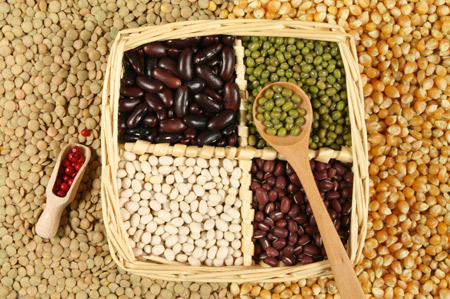 (Agrimoney) – Corn and soybeans rose on Thursday, in the face of a dismal macroeconomic picture, on what appeared to be ongoing fund short-covering, as well as some strong soybean sales.
(Agrimoney) – Corn and soybeans rose on Thursday, in the face of a dismal macroeconomic picture, on what appeared to be ongoing fund short-covering, as well as some strong soybean sales.
It was another bad day for world’s stock markets, as indexes fell in Shanghai, Tokyo, London, Paris and Frankfurt.
The Dow Jones was down 2.0% in afternoon deals in New York.
And oil prices were down as well, with April Brent crude futures back below $30 a barrel, down 2.7% in afternoon deals.
Still, all this doom and gloom is at least pressuring the dollar, which reached a 4-month low against a basket of world currencies, down 0.3% as markets closed.
The weaker dollar is, in theory, supportive for US grain prices, as is lifts dollar-denominated values and encourages exports.
Uncoupled market
Tregg Cronin, of Halo Commodities, said the relative strength in grains “seems to be in-keeping with the ag sector’s disengagement from the outside markets as of late”.
“As of late, it hasn’t seemed to matter if the USD is stronger or weaker, whether crude oil is higher or lower or whether global equities are stable or crashing.”
But Mr Cronin warned that “if our markets are left to trade on their own devices, the fundamentals are uniformly bearish and should pressure prices”.
More short covering
“After a slightly lower move early, the grain and oilseed markets have encountered another round of short covering that has pushed these markets higher.” said Darrell Holaday of Country futures, saying that grains were “oversold”.
“Therefore, the short covering is somewhat expected.”
Mr Holaday also noted an unconfirmed rumour that a major fund is “liquidating all positions,” including its grain shorts.
La Nina warning
Still, there was a touch of fundamental support as well, as attention is turning to the possibility that the current El Nino phenomenon could swing into La Nina later this year.
The La Nina effect, which sometimes follows on the heels of El Nino, is associated with dryness along the west coast of the Americas, and hurricanes in the Atlantic.
The US National Weather Service’s Climate Prediction Centre warned that the possibility of a La Nina year is growing.
Strong soybean sales
And US soybean sales bounced back, after last week’s negative sales, the first of the year.
Weekly export sales data came in at 666,800 tonnes, above the top range of analyst forecasts of 300,000-600,000 tonnes.
March soybeans finished up 1.3%, at $8.73 ½ a bushel.
Disappointing sales
US corn sales were very weak, at 405,000 tonnes, compared to analyst forecasts of 0.8m-1.1m tonnes.
Still, a fresh export sale of 152,000 tonnes was announced on Thursday, for shipment this marketing year to an unknown destination.
Helped by short covering and the weaker dollar, March corn finished up 0.2%, at $3.60 ¼ a bushel.
Russian speculation
US wheat export sales were in line with expectations, at 263,300 tonnes, where analysts had looked for 150,000-350,000 tonnes.
And the EU issued export licences for 589,000 tonnes of soft wheat this week, taking the volume cleared since the start of the 2015-16 marketing year to 16.2m tonnes, lagging last year’s export pace by 15%.
Meanwhile speculation continues to abound on Russia’s intentions with regard to the wheat duty.
Just a couple a weeks ago, rumours were around the possibility of a hike to exports duty, in order to slow domestic price inflation.
But it seems like a cut to the tariff is now on the cards.
Duty could be cut to zero
Russia’s deputy agriculture minister Yevgeny Gromyko said that ministry would like to see the wheat export duty zero, or near zero.
Still, as has been demonstrated in the past, decisions on Russian wheat duties lie in the preview of Prime Minister Medvedev and his deputies, rather than the Agriculture Ministry, so Mr Gromyko’s words are not a statement of intent.
Paris wheat finished down 0.3%, at E153.25 a tonne.
March Chicago Wheat futures finished down 0.7%, at $4.58 ¼ a bushel.
Unica data surprises markets
Sugar futures fell as the Brazilian can harvest showed a surprisingly strong finish.
Sugar production in Brazil’s main center-south cane belt rose to 97,000 tonnes in the second half of January, up from just 29,000 tonnes in the first half of the month, according to data from the cane group Unica.
Production was helped by some drier weather, which allowed for harvesting. There is more uncut cane than usual at this point in the season, due to heavy rains through much of the cutting period.
Additional pressure was heaped on by the weakness of the Brazilian real, down 1.7% against the dollar in afternoon markets, which encourages selling in the world’s top
March raw sugar futures settled down 2.3%, at 13.07 cents a pound.
Macro pressure
And the real weighed on coffee, of which Brazil is also the top exporter, as well, amid a generally bearish macro environment.
May arabica settled down 1.6%, at 115.00 cents a pound.
March robusta coffee settled down 0.7 percent, at $1,382 per tonne.
The weaker tone even affected cocoa, which has recently been finding some strength on ideas of dry weather in West Africa.
May New York cocoa futures settled down 1.9%, at $2,800 a tonne.




